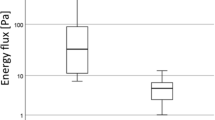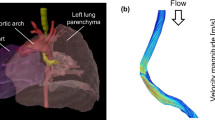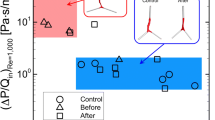Abstract
Congenital tracheal stenosis (CTS) has a high clinical mortality in neonates and infants. Although the procedure of slide tracheoplasty (STP) applied over the years, it is still a challenge for clinicians to predict the surgical timing of the CTS correction. In the present study, we studied on three-dimensional (3D) aerodynamic analysis of an original tracheal model from a specific patient with CTS and bridging bronchus (BB) and four new reconstructed models. We constructed a 3D patient-specific tracheal model based on CT images and applied computer-aided design (CAD) to reconstruct four models to imitate the stenosis development of CTS. Average pressure drop (APD), wall shear stress (WSS) and velocity streamlines were calculated to analyze local aerodynamic characteristics for the evaluation of airflow at the inspiration phase and expiration phase, respectively. We found APD, WSS and AEL decreased during the respiration with the decrease of stenosis. Three abnormal gradients in APD were observed between the main stenosis of trachea arrived at 80% and 60%. This implied the surgical correction may be required when the main stenosis reached 60%. The combination of CAD and aerodynamic analysis is a potential noninvasive tool for surgical timing prediction in the management of patient-specific correction of CTS.
J. Shen and L. Zhu—Co-first author
Access this chapter
Tax calculation will be finalised at checkout
Purchases are for personal use only
Similar content being viewed by others
References
Chung, S.R., Yang, J.H., Jun, T.G., et al.: Clinical outcomes of slide tracheoplasty in congenital tracheal stenosis. Eur. J. Cardio-Thorac. Surg. 47(3), 537–542 (2015)
Grillo, H.C., Wright, C.D., Vlahakes, G.J., et al.: Management of congenital tracheal stenosis by means of slide tracheoplasty or resection and reconstruction, with long-term follow-up of growth after slide tracheoplasty. J. Thorac. Cardiovasc. Surg. 123(1), 145–152 (2002)
Hofferberth, S.C., Watters, K., Rahbar, R., et al.: Management of congenital tracheal. Stenosis. Pediatr. 136(3), e660–e669 (2015)
Mimouni-Benabu, O., Meister, L., Giordano, J., Fayoux, P., Loundon, N., et al.: A preliminary study of computer assisted evaluation of congenital tracheal stenoses: a new tool for surgical decision-making. Int. J. Pediatr. Otorhinolaryngol. 76, 1552–1557 (2012)
Chen, F.L., Horng, T.L., Shih, T.C.: Simulation analysis of airflow alteration in the trachea following the vascular ring surgery based on CT images using the computational fluid dynamics method. J. Xray Sci. Technol. 22, 213–225 (2014)
Cebral, J.R., Summers, R.M.: Tracheal and central bronchial aerodynamics using virtual bronchoscopy and computational fluid dynamics. IEEE Trans. Med. Imaging 23(8), 1021–1033 (2004)
Gemci, T., Ponyavin, V., Chen, Y., et al.: Computational model of airflow in upper 17 generations of human respiratiory tract. J. Biomech. 41(9), 2047–2054 (2008)
Liu, J.L., Itatani, K., Shiurba, R., et al.: Image-based computational hemodynamics of distal aortic arch recoarctation following the Norwood procedure. In: International Conference on Biomedical Engineering and Informatics. IEEE, 318—323. (2011)
Detta, R.A.K., Ducharme, N.G., Pease, A.P.: Simulation of turbulent airflow using a CT based upper airway model of a racehorse. J. Biomech. Eng. 130(3), 13 (2008)
Chien-Yi, H., Liao, H.M., Tu, C.Y., et al.: Numerical analysis of airflow alteration in central
Chang, H.K., Mortola, J.P.: Fluid dynamic factors in tracheal pressure measurement. J. Appl. Physiol. Respir. Environ. Exerc. Physiol. 51(1), 218–225 (1981)
Wilcox, D.C.: Reassessment of the scale determining equation for advanced turbulence models. J. Am. Inst. Aeronaut. Astronaut. 26(11), 1299–1310 (1988)
Mylavarapu, G., Murugappan, S., Mihaescu, M., Kalra, M., Khosla, S., Gutmark, E.: Validation of computational fluid dynamics methodology used for human upper airway flow simulations. J. Biomech. 42, 1553–1559 (2009)
Zhu, L., Liu, J., Zhang, W., et al.: Computational aerodynamics of long segment congenital tracheal stenosis with bridging bronchus. In: Asian Control Conference, pp. 1–5. (2015)
Baden, W., Schaefer, J., Kumpf, M., Tzaribachev, N., Pantalitschka, T., Koitschev, A., Ziemer, G., Fuchs, J., Hofbeck, M.: Comparison of imaging techniques in the diagnosis of bridging bronchus. Eur. Respir. J. 31(5), 1125–1131 (2008)
Zhong, Y.M., Jaffe, R.B., Zhu, M., Gao, W., Sun, A.M., Wang, Q.: CT assessment of tracheobronchial anomaly in left pulmonary artery sling. Pediatr. Radiol. 40(11), 1755–1762 (2010)
Acknowledgement
We have been genuinely appreciative of the support of the National Nature Science Foundation of China (No. 81602818, P.I.: Limin Zhu and No. 81501558, P.I.: Jinlong Liu), the Project-sponsored by the Scientific Research Foundation for the Returned Overseas Chinese Scholars, State Education Ministry (No. 20144902, P.I.: Jinlong Liu), the Fund of The Shanghai Committee of Science and Technology (No. 15411967100, P.I.: Limin Zhu and No. 14411968900, P.I.: Jinlong Liu) and the Biomedical and Engineering (Science) Inter-disciplinary Study Fund of Shanghai Jiaotong University (No. YG2014MS63, P.I.: Jinlong Liu).
Author information
Authors and Affiliations
Corresponding authors
Editor information
Editors and Affiliations
Rights and permissions
Copyright information
© 2017 Springer Nature Singapore Pte Ltd.
About this paper
Cite this paper
Shen, J. et al. (2017). Surgical Timing Prediction of Patient-Specific Congenital Tracheal Stenosis with Bridging Bronchus by Using Computational Aerodynamics. In: Fei, M., Ma, S., Li, X., Sun, X., Jia, L., Su, Z. (eds) Advanced Computational Methods in Life System Modeling and Simulation. ICSEE LSMS 2017 2017. Communications in Computer and Information Science, vol 761. Springer, Singapore. https://doi.org/10.1007/978-981-10-6370-1_18
Download citation
DOI: https://doi.org/10.1007/978-981-10-6370-1_18
Published:
Publisher Name: Springer, Singapore
Print ISBN: 978-981-10-6369-5
Online ISBN: 978-981-10-6370-1
eBook Packages: Computer ScienceComputer Science (R0)




